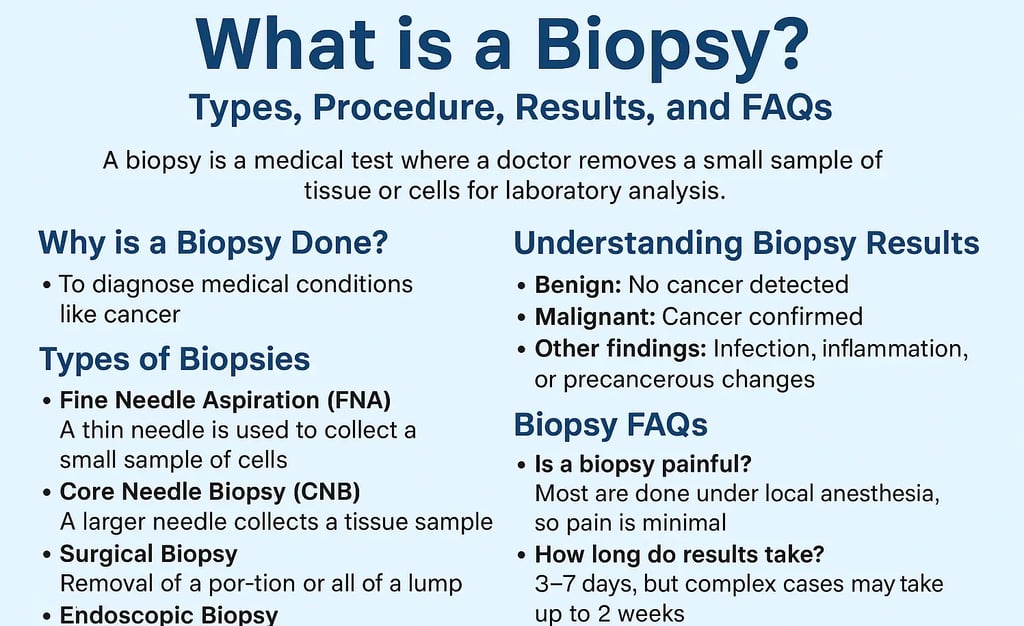What is a Biopsy? Types, Procedure, Results, and Importance in Diagnosis
Learn what a biopsy is, how it’s performed, and why it’s essential for diagnosing conditions like cancer. Explore different types of biopsies, the procedure steps, and how to interpret biopsy results.


What is a Biopsy? A Complete Guide
A biopsy is a medical procedure where doctors collect a small sample of tissue or cells from a specific part of the body for laboratory examination. This test is crucial for identifying abnormalities, especially cancer. By studying the extracted cells under a microscope, healthcare professionals can determine whether the tissue is benign (non-cancerous) or malignant (cancerous), which helps guide treatment decisions.
Why is a Biopsy Done?
Doctors usually recommend a biopsy when scans such as X-rays, ultrasounds, or MRIs reveal unusual growths or abnormalities. Unlike imaging tests, a biopsy provides a definitive diagnosis by confirming whether abnormal cells are present. This makes it one of the most important diagnostic tools in modern medicine.
Types of Biopsies
Biopsies come in several forms, each suited to different conditions:
1. Fine Needle Aspiration (FNA)
Uses a thin needle to remove a small sample of cells.
Commonly used for thyroid nodules, breast lumps, or lymph nodes.
Advantages: quick, minimally invasive, and requires little recovery.
Limitation: may not always collect enough tissue for a conclusive result.
2. Core Needle Biopsy (CNB)
Uses a larger needle to collect more tissue than FNA.
Often performed for breast, liver, and prostate biopsies.
Advantages: higher diagnostic accuracy.
Limitation: slightly more discomfort and risk of bruising.
3. Surgical Biopsy
Involves removing a portion (incisional) or the entire abnormal area (excisional).
Provides detailed information on tissue structure.
Usually reserved for cases where other biopsy methods are inconclusive.
4. Endoscopic Biopsy
Uses an endoscope (a flexible tube with a camera) to view internal organs like the stomach, lungs, or intestines.
Allows doctors to target and collect samples directly from suspicious areas.
5. Skin Biopsy
Used for diagnosing skin conditions and cancers.
Techniques include shave biopsy, punch biopsy, and excisional biopsy, depending on the lesion type.
The Biopsy Procedure: What to Expect
Before the procedure, patients are advised to:
Inform doctors about any medications (especially blood thinners).
Avoid eating or drinking if sedation is required.
During the procedure:
The doctor explains the process and answers questions.
Local anesthesia is usually given to numb the area.
Depending on the method, a needle, surgical tool, or endoscope is used to collect the sample.
Most biopsies are outpatient procedures, meaning patients can return home the same day with minimal recovery time.
Interpreting Biopsy Results
After the biopsy, the sample is sent to a pathology lab, where specialists examine it under a microscope.
Benign results: No cancer or serious disease is present. The doctor may recommend monitoring.
Malignant results: Confirms cancer. Further tests such as imaging scans may be required to plan treatment (surgery, chemotherapy, or radiation).
Other findings: Infections, inflammatory conditions, or precancerous changes may also be detected.
The waiting period for results usually takes a few days to two weeks, depending on the complexity. Patients are encouraged to discuss the results thoroughly with their healthcare provider to understand the next steps.
Conclusion
A biopsy is an essential diagnostic tool that helps doctors detect and confirm serious conditions like cancer. Understanding the different types of biopsies, the procedure involved, and what results mean can reduce anxiety and help patients make informed decisions about their health.
By working closely with healthcare providers, patients can ensure timely diagnosis and appropriate treatment planning, improving their overall outcome.
Frequently asked questions
1. Is a biopsy painful?
Most biopsies are performed under local anesthesia, so pain is minimal. Patients may feel mild pressure or soreness afterward.
4. What should I avoid after a biopsy?
Avoid strenuous activity, heavy lifting, or swimming for at least 24–48 hours, unless your doctor advises otherwise.
2. How long does it take to recover from a biopsy?
Recovery depends on the type. Needle biopsies often need little to no downtime, while surgical biopsies may take a few days to weeks.
5. Can a biopsy spread cancer?
No, a biopsy does not cause cancer to spread. It is a safe and essential diagnostic tool.
3. How long do biopsy results take?
On average, 3–7 days, but complex cases may take up to 2 weeks.
6. Are all biopsies done for cancer?
No. Biopsies can also detect infections, autoimmune diseases, inflammatory conditions, and skin disorders.
